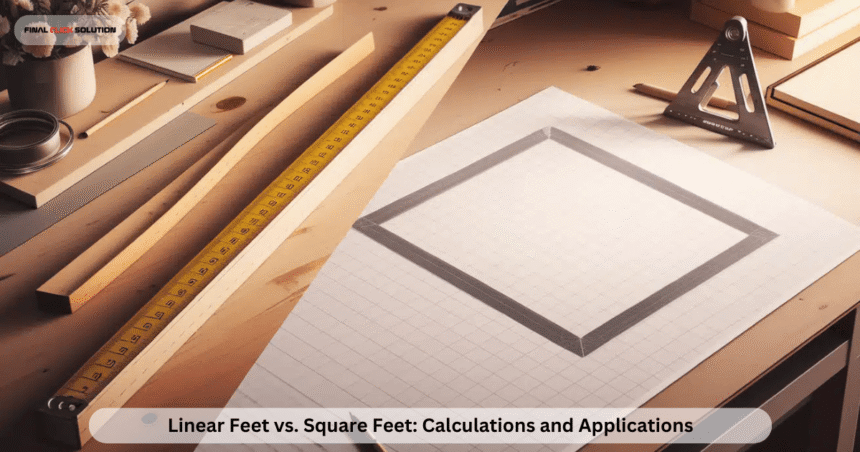In the world of construction, home improvement, landscaping, and even everyday DIY projects, measurements matter immensely. Two of the most commonly encountered units are linear feet and square feet. While they might sound similar, confusing them can lead to significant errors, such as purchasing too much or too little material, wasting money, or delaying your project. This comprehensive guide will delve deep into the differences between linear feet and square feet, explain how to calculate each accurately, and provide practical advice on when and how to use them. We’ll also cover essential conversions like square feet to linear feet, sqft to linear ft, converting square feet to linear feet, converting linear feet to square feet, and more. Whether you’re a homeowner tackling a renovation, a contractor estimating costs, or simply curious about these measurements, this article will equip you with the knowledge to handle them confidently.
What Is a Linear Foot?
At its core, a linear foot is a straightforward unit of measurement that focuses solely on length. It represents one foot (12 inches) in a straight line, without considering width, height, or depth. The term “linear” emphasizes its one-dimensional nature, it’s all about how far something extends in a single direction.
But what makes a linear foot distinct from just a regular foot? In practical terms, it’s often used in industries where materials are sold or measured based on their length alone. For example, imagine you’re buying a rope, a piece of trim, or a length of pipe. The price is typically quoted per linear foot, ignoring the material’s cross-sectional dimensions. This simplicity makes it ideal for items that come in rolls, strips, or elongated forms.
Historically, the linear foot has roots in ancient measurement systems, evolving from units like the Roman pes (foot) to modern imperial standards. Today, it’s ubiquitous in the United States and other countries using imperial measurements, though metric equivalents like meters serve similar purposes globally.
How to Calculate Linear Feet
Calculating linear feet couldn’t be simpler, it’s essentially just measuring length. If you’re working with a tape measure, stretch it along the straight path of the item or space you need to cover.
Here’s the basic process:
- Measure the total length in inches or feet.
- If in inches, divide by 12 to convert to feet.
- For multiple segments, add up the individual lengths.
Example 1: Single Piece
Suppose you’re installing crown molding along a wall that’s 144 inches long. Divide 144 by 12, and you get 12 linear feet.
Example 2: Perimeter Calculation
For fencing a rectangular yard that’s 50 feet long and 30 feet wide, calculate the perimeter: (50 × 2) + (30 × 2) = 160 linear feet. This ignores the area inside; it’s purely the boundary length.
If you’re dealing with irregular shapes, break them into straight sections and sum them up. Tools like laser measures can make this precise, especially for longer distances.
One common pitfall is forgetting to account for overlaps or cuts. Always add 5-10% extra for waste when ordering materials.
Common Uses of Linear Feet
Linear feet pop up in numerous applications across various fields:
- Construction and Lumber: Boards, beams, and trim are often priced per linear foot. A 2×4 board, for instance, is sold based on its length, not its width or thickness.
- Plumbing and Electrical: Pipes, wires, and conduits are measured linearly, as their diameter is standardized.
- Home Interiors: Countertops in kitchens or bathrooms are quoted per linear foot, factoring in the standard depth but charging based on run length.
- Landscaping and Fencing: Chain-link or wooden fences require linear footage to determine material needs.
- Textiles and Fabrics: When buying from a bolt, fabric is cut and sold by linear feet, assuming a fixed width.
- HVAC and Ductwork: Air ducts are calculated by their extended length.
In manufacturing, linear feet help in production lines for items like conveyor belts or cables. Understanding these uses ensures you don’t mix up measurements with area-based ones.
What Is a Square Foot?
Shifting gears, a square foot is a two-dimensional unit that measures area. It represents the space covered by a square that’s one foot on each side, essentially, 144 square inches.
This measurement accounts for both length and width, making it perfect for surfaces where coverage matters. Unlike linear feet, which are linear (pun intended), square feet capture the expanse of a plane.
The square foot is a staple in real estate, where it’s used to denote living space, but its applications extend far beyond. It’s part of the imperial system, with the metric counterpart being square meters (about 10.76 square feet per square meter).
How to Calculate Square Feet
The formula for square feet is basic multiplication: Square Feet = Length (in feet) × Width (in feet).
For non-rectangular areas:
- Triangles: (Base × Height) / 2
- Circles: π × Radius²
- Irregular shapes: Divide into simpler polygons and sum.
Example 1: Room Flooring
A bedroom measures 15 feet by 12 feet. 15 × 12 = 180 square feet.
Example 2: Wall Painting
For a wall 8 feet high and 10 feet wide, minus a 3×4 foot window: (8 × 10) – (3 × 4) = 80 – 12 = 68 square feet.
Always measure accurately, use a level for straight lines and account for irregularities like alcoves. Online calculators can help for complex shapes.
Common Uses of Square Feet
Square feet dominate when area is key:
- Flooring and Carpeting: Tiles, vinyl, or hardwood are sold by square footage to cover the ground plane.
- Painting and Wall Coverings: Paint coverage is estimated per square foot, often 300-400 sq ft per gallon.
- Real Estate and Architecture: Home sizes are listed in square feet, influencing valuations and taxes.
- Roofing: Shingles are bundled for 100 square feet (a “square” in roofing terms).
- Landscaping: Mulch, sod, or pavers require square footage calculations.
- Insulation and HVAC: Building codes often specify R-values per square foot.
In commercial settings, square footage determines lease rates or energy efficiency ratings.
Differences Between Linear Feet and Square Feet
To clarify, here’s a comparison table:
| Feature | Linear Foot | Square Foot |
| Dimensionality | One-dimensional (length only) | Two-dimensional (length × width) |
| Primary Use | Measuring straight-line distances | Measuring surface areas |
| Examples | Trim, pipes, fencing | Floors, walls, roofs |
| Calculation | Direct measurement or inches/12 | Length × Width |
| Common Industries | Lumber, textiles, plumbing | Construction, real estate, painting |
| Conversion Needs | Requires width for area conversion | Requires division by width for length |
The key takeaway? Linear feet ignore breadth, while square feet embrace it.
When to Use Linear Feet vs. Square Feet
Choose linear feet for elongated items where width is fixed or irrelevant, think borders or runs. Opt for square feet when filling a space, like covering a floor.
Scenario: Installing baseboards (linear) vs. laying tile (square). Misusing them? You might order 100 linear feet of tile, only to find it covers far less area than needed.
Converting Between Linear Feet and Square Feet
Conversions are crucial for mixed measurements. Keywords like “convert square feet to linear feet,” “sqft to linear ft,” “convert sq ft to linear ft,” “sq feet to linear feet,” “lf to sf,” “linear feet to square foot calculator,” “linear ft to sq ft converter,” and “sq ft conversion to linear ft” highlight common searches.
Linear Feet to Square Feet (LF to SF):
Formula: Square Feet = Linear Feet × Width (in feet)
Example: 20 linear feet of 4-foot-wide fabric: 20 × 4 = 80 square feet.
Square Feet to Linear Feet:
Formula: Linear Feet = Square Feet / Width (in feet)
Example: 120 square feet of 3-foot-wide carpet: 120 / 3 = 40 linear feet.
Use online tools like a linear feet to square foot calculator for quick results, but always verify inputs.
Cost Differences and Practical Tips
Materials priced per linear foot (e.g., $5/LF for countertops) vs. per square foot ($2/SF for tile) affect budgets. Linear pricing suits uniform-width items, while square suits variable coverage.
Tip: Factor in waste, add 10-15%. For conversions, measure widths accurately. In bulk buys, compare units to avoid overpaying.
Conclusion
Mastering linear feet vs. square feet is essential for accurate planning and cost savings in any project. Linear feet handle lengths efficiently, while square feet cover areas comprehensively. By understanding calculations, uses, and conversions, like square feet to linear feet or convert sq ft to linear ft, you’ll avoid common pitfalls. Remember, precision starts with the right unit. Next time you’re at the hardware store, double-check: Is it length or area? With this knowledge, your projects will measure up perfectly.
Frequently Asked Questions (FAQs)
- How do I convert square feet to linear feet? Divide square footage by the material’s width in feet.
- What’s the difference between sqft to linear ft and linear ft to sq ft? The former divides by width; the latter multiplies.
- Can I use a linear feet to square foot calculator online? Yes, many free tools exist—input dimensions for instant results.
- Why can’t I directly convert sq ft to linear ft without width? Because linear ignores area; width bridges the gap.
- How many linear feet in a square foot? It varies; for 1-foot-wide material, 1 SF = 1 LF.
- Is there a standard for sq feet to linear feet in flooring? Yes, but always specify width.
- What’s lf to sf in fencing? Multiply fence length by height for area.
- How accurate is a linear ft to sq ft converter? As accurate as your inputs—double-check measurements.
- Common mistakes in sq ft conversion to linear ft? Forgetting units or ignoring waste.
- Are there apps for converting linear feet to square feet? Yes, like construction calculators on mobile stores.








